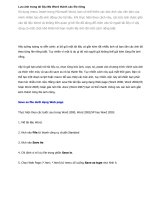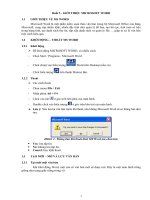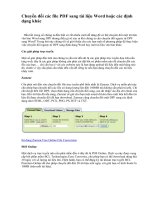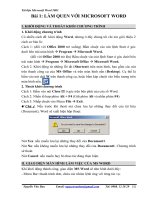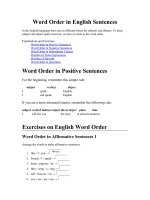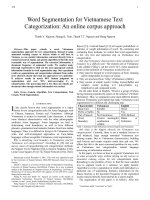Tài liệu Word Segmentation for Vietnamese Text Categorization: An online corpus approach pptx
Bạn đang xem bản rút gọn của tài liệu. Xem và tải ngay bản đầy đủ của tài liệu tại đây (372 KB, 6 trang )
172
1
Abstract—This paper extends a novel Vietnamese
segmentation approach for text categorization. Instead of using
annotated training corpus or lexicon which is still lack in
Vietnam, we use statistic information extracted directly from a
commercial search engine and genetic algorithm to find the most
reasonable way of segmentation. The extracted information is
document frequency of segmented words. We conduct many
thorough experiments to find out the most appropriate mutual
information formula in word segmentation step. Our experiment
results on segmentation and categorization obtained from online
news abstracts clearly show that our approach is very optimistic.
It achieves results in nearly 80% human judgment on
segmentation and over 90% micro-averaging F
1
in
categorization. The processing time is less than one minute per
document when enough statistic information was cached.
Index Terms—Genetic Algorithm, Text Categorization, Web
Corpus, Word Segmentation.
I. I
NTRODUCTION
t has clearly known that word segmentation is a major
barrier in text categorization tasks for Asian languages such
as Chinese, Japanese, Korean and Vietnamese. Although
Vietnamese is written in extended Latin characters, it shares
some identical characteristics with the other phonographic
southeast Asian languages. Asian languages are hard in
determining word boundaries, as well as have different
phonetic, grammatical and semantic features from Euro-Indian
languages. Thus, it is difficult in trying to fit Vietnamese into
wide- and well-investigated approaches on Euro-Indian
languages without acceptable Vietnamese word segmentation.
Why is identifying word boundary in Vietnamese vital for
Vietnamese text categorization? According to [18] and our
survey, most of top-performing text categorization methods:
the Support Vector Machine ([8]), k-Nearest Neighbor ([16]),
Linear Least Squares Fit ([17]), Neural Network ([15]), Naïve
Manuscript received December 4, 2005. This work was supported in part
by the University of Natural Sciences 2004-2005 Research Grant for young
lecturer.
Thanh V. Nguyen is a lecturer of the Faculty of Information Technology,
University of Natural Sciences, HoChiMinh, Vietnam. He is now a graduate
student at the Department of Computer Science & Enginnering, University of
Minnesota at Twin Cities, MN 55455 USA (phone: (1) 651-399-9557; e-mail:
).
Hoang K. Tran and Thanh T.T. Nguyen are seniors at the Faculty of
Information Technology, University of Natural Sciences, HoChiMinh,
Vietnam. (e-mail: {azury_thanh, trankhaihoang}@yahoo.com).
Hung Nguyen is a lecturer of Vietnam National University, HoChiMinh,
Vietnam (e-mail: ).
Bayes ([1]), Centroid-based ([13]) all require probabilistic or
statistics or weight information of word
1
. By examining and
evaluating these methods, we realize that word segmentation
is the very first and important step on Vietnamese text
categorization.
And what Vietnamese characteristics make identifying word
boundary be a difficult task? The element unit of Vietnamese
is the syllable (“tiếng”), not the word (“từ”). Some unanimous
points of the definition of Vietnamese words ([5]) are:
• They must be integral in several respects of form, meaning
and be independent in respect of syntax.
• They are structured from “tiếng” (Vietnamese syllable)
• They consist of simple words (1-tiếng, monosyllable) and
complex words (n-tiếng, n<5, polysyllable), e.g.
reduplicative and compound words.
On the other hand, in English, “Word is a group of letters
having meaning separated by spaces in the sentence” (Webster
Dictionary). Thus, we summarize some main different features
between Vietnamese and English that make Vietnamese word
segmentation be a difficult and challenging task.
Characteristic Vietnamese English
Basic Unit Syllable Word
Prefix or Suffix No Yes
Part of Speech Not Unanimous Well-Defined
Word
Boundary
Context meaningful
combination of
syllable
Blank or
Delimiters
Table 1. Summary of main differences between English and Vietnamese.
And what is the biggest obstacle for Vietnamese text
categorization? Currently, there is not a standard lexicon or
well balanced, large enough annotated Vietnamese text
training corpus. Due to Vietnamese characteristics, building
such lexicon and corpus requires much time and cost. We
affirm that this is the most concerned problem for any works
on Vietnamese text categorization, natural language
processing or information retrieval.
In this paper, we focus on how to segment Vietnamese text
in some acceptable ways without relying on any lexicon or
annotated training corpus for text categorization tasks.
Remarking to the problem of how to find the most satisfied
way to segment words in a sentence, we apply Genetic
Algorithm to evolve a population in which each individual is a
particular way of segmenting. Statistics information for the
fitness function is the document frequency of the segmented
words extracted directly from Internet by a search engine.
The organization of this paper is as follows. After this
1
Sometimes called “word stem” or “term”
Word Segmentation for Vietnamese Text
Categorization: An online corpus approach
Thanh V. Nguyen, Hoang K. Tran, Thanh T.T. Nguyen and Hung Nguyen
I
172
2
introduction, we will look back to state of the art of Chinese
and Vietnamese word segmentation. Section 3 expresses our
principle of internet-based statistic. In the next section, we
describe in detail our genetic algorithm approach. Section 5
shows some experimental results and discussions. Finally, we
conclude and provide directions for future research.
Figure 1. Basic Approaches of Chinese Segmentation and Current Works
of Vietnamese Segmentation.
II. R
ELATED WORKS
In this section, we examine some significant prior work on
Vietnamese segmentation and also try to categorize them
based on the art of Chinese segmentation ([7]).
Word-based approaches, with three main categories:
statistics-based, dictionary-based and hybrid, try to extract
complete words from sentences. Statistics-based approaches
must rely on statistical information such as term, word,
character frequencies or co-occurrences in a set of preliminary
data. Therefore, its effectiveness is significantly depended on
a particular training corpus. In dictionary-based approaches,
segmented texts must be matched with the ones in dictionary.
Unfortunately, it is unfeasible to build a complete Vietnamese
dictionary or a well-balanced, large enough training corpus as
we stated above. Hybrid approaches try to apply different
ways to take their advantages. Dinh et al ([6]) have built their
own training corpus (about 10MB) based on Internet
resources, news and e-books. Of course, they are small and
not well-balanced corpus. To sum up, we argue that word-
based approaches are not suitable for Vietnamese text
categorization until we have a good lexicon and/or a large and
trusted training corpus.
Character-based approaches (syllable-based in
Vietnamese case) purely extract certain number of characters
(syllable). It can further be classified into single-based (uni-
gram) or multi-based (n-gram) approaches. Although they are
simple and straightforward, many significant results in
Chinese are reported ([7]). Some recent publications for
Vietnamese segmentation also follow this one. Le ([9]) has
built a 10 MB raw corpus and used dynamic programming to
maximize the sum of the probability of chunks (phrases
separated by delimiters). In a recent publication of H. Nguyen
et al ([12]), instead of using any raw corpus, he extracted the
statistic information directly from Internet and used genetic
algorithm to find most optimal ways of segmenting the text.
Although his work is still preliminary and lack of thorough
experiments, we believe that this novel approach is promising.
Our work will extend this idea, give significant changes and
make some considerate experimental evaluations to find the
best mutual information formula, the key point of this
approach.
III. P
RINCIPLE OF INTERNET
-
BASED STATISTIC
We agree with H. Nguyen et al ([12]) that through
commercial search engines, we can extract useful statistic
information from Internet. This is the document frequency
(df), the number of indexed documents containing this word.
To approximate the probability of a word randomly occurred
on the Internet, we normalize the df value by dividing it by a
MAX value, which is the number of indexed Vietnamese
documents.
()
()
df w
pw
MAX
=
As we do not know exactly how many Vietnamese
documents have been indexed, by testing some common
words, we choose MAX to be 1 * 10
9
.
Vietnamese English
df
có has / have 21.3 * 10
6
của of 20.4 * 10
6
một one 14.4 * 10
6
Table 2. Document frequencies of some common Vietnamese words
.
Vietnamese word contains consecutive syllables, thus, we
need a statistic measure of syllable associations. Mutual
information (MI), an important concept of information theory,
has been used in natural language processing to capture the
relationship between two specific words x, y ([3]):
(;)
(; ) log
() ()
pxy
MI x y
px py
≡
×
However, we not only look at pairs of syllables, bigrams,
but also consider n-grams as well. Many formulas were
introduced to measure the relationship of n consecutive
syllables. However, it is difficult to find the most appropriate
formula for our task. So, we will experiment on three
approaches given by [2], [12] and us.
Chien et al ([12]) suggests calculate the mutual information
for Chinese n-gram as follow:
()
() 1
() ( ) ( )
pcw
MIcw MI
plw prw pcw
==
+−
where cw is composed of n single syllables (cw=s
1
s
2
…s
n
), lw
and rw are the two longest composed substrings of cw with
the length n-1, i.e., lw=s
1
s
2
…s
n-1
and rw=s
2
s
3
…s
n
. Basically, if
MI(cw) is large, lw and rw seem to occur together on Internet,
i.e., cw is likely a compound word.
Another formula introduced by [12] specifies for
Vietnamese:
1
()
() 2
() ( )
n
i
pcw
MIcw MI
ps pcw
i
=
==
−
∑
Chinese seg
Character-based
Unigram
Word-based
N-gram
Statistic
Dictionary Hybrid
Full word / Phrase Component
Longest M. Shortest Match Overlap M.
Vietnamese seg
Le A. H.
Dinh D. (01)
Ours (05)
H. Nguyen (05)
172
3
However, we argue that both above formulas have some
drawbacks. Most of Vietnamese 4-grams are actually the
combination of two 2-syllable words, for example “hội nghị
khoa học”. So, instead of comparing a 4-syllable word with
two sub 3-grams, we should consider it with two sub distinct
2-grams. Meanwhile, the latter favors words having one or
two syllables since the more syllables a word contains, the
larger denominator it gets. Consequently, it has a low MI.
With above intuition, we represent a new way to calculate the
mutual information of Vietnamese n-grams:
()
() 3
() ( ) ( )
pcw
MIcw MI
plw prw pcw
==
+−
where lw and rw are the two composed substrings of cw with
the length
⎡⎤
/2n
. We can easily find that our formula is
similar to the one given by Chien et al ([2]) for 2-grams and 3-
grams but different from words having four, or more,
syllables.
In the next section, we will introduce genetic algorithm
approach to find the global optimal MI for a given text, i.e. the
most acceptable segmentation for this text.
IV. G
ENETIC ALGORITHM APPROACH
The search space of word segmentation is very large since
there are many ways to combine syllables into words. Base on
the principle of evolution and heredity, Genetic Algorithm
(GA) has long been known for its ability to traverse very large
search space efficiently and find approximate global optimal
solutions instead of local optimal solutions ([10]). GA will
evolve a number of generations. For each generation, we will
select top N best quality individuals after performing cross-
over, mutation and reproduction. The quality of an individual
will be calculated by a fitness function.
Goal. Let the given text t be composed of n syllables:
t=s
1
s
2
…s
n
. The goal of this GA process is to find most
acceptable ways to segment t to m segments: t=w
1
w
2
…w
m
which w
k
=s
i
…s
j
(1≤ k≤ m, 1≤ i,j≤ n) can be either a simple or
complex word.
Representation. The population (pop) is represented as a
set of individuals (id) which are strings of 0s and 1s bit. Each
bit is corresponding to a syllable. So a word will be a
meaningful consecutive string of bits. For example:
0 0 1 0 0
Học sinh # học # sinh học (pupil study biology)
w
1
w
2
w
3
Initialization. In this step, we must set several parameters
for the GA such as number of generations, population size,
cross-over fraction, mutation fraction and reproduction
fraction. We also have to randomly build an initial population,
randomizing a 0s and 1s string. However, we make some
restrictions on the random string for optimization. Table 3 a
statistic derived from an online usual dictionary
2
containing
72994 words and phrases.
Through this statistic, we see that there are over 67% of the
words containing two syllables and about 30% consisting of
one, three or four syllables. Longer words, many of which are
idiomatic expressions, are about 3%.These lead us to define
2
some restrictions on the initial random string. First, we limit
the length of each segment w
k
with four. Second, when
randomizing, we set a bias ratio to generate more segments
having the length 2 than the others. Besides, we also apply the
simple form of the Left Right Maximum Matching algorithm
([14]) to build two specific individuals, forward / backward
ones. Consequently, the initial population will have some
local optimal individuals.
Word length Frequency Percentage
1 8933 12.2
2 48995 67.1
3 5727 7.9
4 7040 9.7
≥ 5 2301 3.1
Total
72994 100
Table 3. Statistics of word lengths in a dictionary
.
Cross-over. We apply the standard one-point cross
operation on bit strings. For a couple of two individuals id
1
id
2
, the two new offsprings are combined the beginning of id
1
with the ending of id
2
and vice-versa. However, if a child
individual breaks the above restriction, each segment w
k
cannot have the length greater than four(4), we will normalize
them by flipping over all exceeding bits at the end of this
segment.
Mutation. Instead of using random inversion mutation, we
invert only boundary bits of a segment. Like the cross-over,
we apply the normalization to ensure the mutative individual
satisfying the restriction.
Reproduction. After performing cross-over and mutation,
we will mingle a proportion of the parent individuals into
child individuals for the selection step of next generation.
Selection. For each generation, we only select top N
individuals from child and reproduction parent candidates for
the next generation. The selection is based on the following
fitness function
() ( ... ) ( )
12
1
m
fit id fit w w w MI w
mk
k
==
∑
=
() ()
1
N
fit pop fit id
i
i
=
∑
=
where id=w
1
w
2
…w
m
is a particular individual of the
population, pop = {id
1
, …, id
N
}
Convergence. The GA process tries to improve the fitness
of the individual i.e. the quality of word segmentation. Thus,
we will stop the GA process when the fitness value of the next
generation is convergent or the number of generations
reaches a pre-defined maximum.
Example: “Nhà nước # xây # cao ốc #thương mại.”
(The government builds commercial buildings.)
Initialization: id
1
= 0110101 fit(id
1
) = 0.020
id
2
= 0011011 fit(id
2
) = 0.699
Cross-over:
Mutation:
id
2
= 0010101 → id
2
= 0010011 fit(id
2
) = 0.704
(Nhà nước # xây # cao ốc # thương mại.) (convergence)
id
1
= 011 0101 → id
1
= 0111011 fit(id
1
) = 0.464
id
2
= 001 1011 → id
2
= 0010101 fit(id
2
) = 0.255
172
4
Word df p MI3
nhà 2180000 2.18E-03 2.18E-03
nước 1840000 1.84E-03 1.84E-03
nhà nước 771000 7.71E-04 2.37E-01
nước xây 9360 9.36E-06 2.38E-03
xây 2100000 2.10E-03 2.10E-03
xây cao 287 2.87E-07 2.13E-05
cao 11400000 1.14E-02 1.14E-02
cao ốc 35300 3.53E-05 3.04E-03
ốc 239000 2.39E-04 2.39E-04
ốc thương 277 2.77E-07 1.12E-04
thương 2230000 2.23E-03 2.23E-03
thương mại 1260000 1.26E-03 4.62E-01
mại 1760000 1.76E-03 1.76E-03
nước xây cao 0 0.0E+00 0.0E+00
Table 4. Statistics of n-grams in “Nhà nước xây cao ốc thương mại”
.
V. E
XPERIMENTAL RESULTS AND DISSCUSSION
Evaluating the accuracy of Vietnamese word segmentation
is very problematic, especially without a manual segmentation
test corpus. Therefore, we perform two experiments, one is
done by human judgment for word segmentation result, and
the other is a text categorization evaluation based on our word
segmentation approach.
Due to the fact that our approach use internet-based statistic,
we harvest news abstracts from many online newspapers
3
to
build a corpus for testing purpose. Thus, somehow our data is
balanced in styles and genres. Moreover, for the text
categorization experiment, we automatically classify these
abstracts into two levels of topics based on the current
categorization of news websites (Table 5).
Level 1 Level 2
Science
Society Education, Study abroad , Life
style, Travel
Business Estate, Stock, Foreign trade
Sport Football ,Tennis
Culture Fashion, Cinema
Health Making up, Sex
Table 5. Two levels of topics of testing corpus.
Since each online newspaper has its own topic
categorization, we choose the most common topics from these
websites. In summary, we collect a 10MB testing corpus
containing 1400 abstracts and 82,219 syllables, 100
documents for each sub topic.
For our experiments, we set genetic parameters as follows:
• Generation limit = 100
• Population size = 100
• Cross-over fraction = 0.8
• Mutation fraction = 0.1
• Reproduction fraction = 1
• Top N selection = 100
3
, ,
,
A. Word Segmentation Experiment
In this experiment, we ask two native, one is a linguistic
professor and the other is a computer science graduate student,
who usually reads online news. These people will examine our
segmentation results and answer two questions:
• Whether or not he absolutely agrees with the segmentation
result. (This question is used for calculating perfect
segmentation).
• Whether or not the segmentation result makes the reader
understand the meaning correctly. (This question is used
for calculating acceptable segmentation).
We argue that, for text categorization task, we just need
acceptable ways of segmentation, i.e. the important words are
segmented correctly while less important words may be
segmented incorrectly. Table 6 represents the human
judgment for our word segmentation approach.
Judgment MI Perfect Acceptable
MI1 703 (50.18%) 1076 (76.86%)
MI2 736 (52.57%) 1074 (76.72%)
Linguist
Professor
MI3 787 (56.24%) 1132 (80.86%)
MI1 759 (54.19%) 1088 (77.71%)
MI2 747 (53.36%) 1063 (75.94%)
Graduate
Student
MI3 862 (61.57%) 1175 (83.91%)
Table 6. Human judgment for word segmentation experiment
.
Our experiment shows that there is no significant difference
in word segmentation result among three MI formulas.
However, our proposed MI gets the best performance. This is
not a surprising result. We believe that the our MI3 formula
overcomes the drawbacks of the other MI formula in
evaluating words having four or more syllables while
reserving the existing evaluation for 2,3-grams.
Overall, the perfect segmentation percentage seems to be
low as we expect. Moreover, there is considerable difference
in the agreement of how a sentence is segmented perfectly
among judge. The reason is that part-of-speech system of
Vietnamese is not well-defined. This causes the
inhomogeneous phenomenon in judgment word segmentation.
However, the acceptable segmentation percentage is
satisfactory. Nearly eighty percent of word segmentation
outcome does not make the readers misunderstand the
meaning. This is exactly what we expected. Without training
corpus, our approach achieves a considerable Vietnamese
segmentation result. Therefore, we continually make a
preliminary text categorization experiment to examine further
our approach. We only use MI3 formula in word segmentation
step for the next experiment.
B. Text Categorization Experiment
As we stated above, there are many approaches performing
text categorization task. Nevertheless, the best performance
approach for English may not be the best one for Vietnamese.
To find the most appropriate text categorization approach for
Vietnamese with our suggested word segmentation, we need
many aggressive experiments with large data. We leave this
task for future works.
In this part, we perform a simple text categorization
experiment for testing our segmentation approach based on
172
5
the idea of Naïve Bayes approach ([1]). The testing corpus
consists of a set of documents, D={d
1
, d
2
,…,d
n
}, where each
document will be labeled with a unique category from a set of
classes C={c
1
, c
2
,…,c
m
}. For each document d, we apply some
pre-processing steps to speed up. First, we split d into many
groups of syllables based on the delimiters and numbers.
Second, using a stop word list, we remove common and less
informative words based on a stop word list. Performing word
segmentation task on d we get a segmented document. Finally,
d will be represented as follows: d =g
1
g
2
…g
r
where g
i
is a
group of syllables, a word, after segmentation.
Naïve Bayes approach makes an assumption that the words
g
1
::g
r
are all conditionally independent of one another, given
document d. We cite the following formula from [11]:
12
()(| )
( | ... )
()(| )
kik
i
kn
jij
ji
PY c P g Y c
PY c gg g
PY c P g Y c
==
==
==
∏
∑∏
where c
k
is the k
th
topic and d=g
1
g
2
…g
r
is the document we
want to categorize.
Nevertheless, given a topic c
k
, we can not calculate the
conditional probability P(g
i
| Y=c
k
) that a word g
i
belongs to
that category c
k
since we do not have a training corpus. So we
have to utilize it approximately using the information from the
search engine as follows:
#{ }
(|)
#{ }
(&)1
(&)||||
ij
ij
j
ij
ik
k
DX g Y c
PX g Y c
DY c
pg c
p gc Y
=∧=
===
=
+
≈
+
∑
where #D{x} operator returns the number of elements in the
set D that satisfy property x while p(g
i
& c
k
) is calculated as
described in Section 3. Moreover, we have to smooth the
probability to avoid zero estimation by adding some additional
number to the numerator and denominator.
#{ } ()
()
|| || ( )
ii
i
j
j
DY c pc
PY c
Ypc
=
== ≈
∑
With these modified formula, we now can calculate the
probability P(Y=c
k
| g
1
g
2
…g
r
) that a given document d
=g
1
g
2
…g
r
belongs to a category c
k
using the document
frequency information returned from a commercial search
engine. Since we are only interested in the most probable
category for a document, we use the Naïve Bayes
classification rule:
()(| )
arg max
()(| )
k
kik
i
c
jij
ji
PY c P g Y c
Y
PY c Pg Y c
==
←
==
∏
∑∏
Our experiment assumption is that each document has and
only has one category. We will use F
1
and micro-averaging F
1
measure described in [16] to evaluate performance.
Table 7 shows the results on our testing corpus for all level-
1 topics and their micro-averaging. We compare our approach
result with IGATEC introduced by [12].
Category Ours IGATEC
Science 95.2 90.9
Society 82.9 78.1
Business 88.5 87.4
Sport 93.7 87.6
Culture 96.4 96.0
Health 89.5 90.3
Micro-avg 91.03 88.38
Table 7. F1 and micro-averaging F1 performance of our approach and
IGATEC
for level-1 topics.
The experiment shows that our approach slightly
outperforms IGATEC. Moreover, we claim that applying
above pre-processing steps can help GA process reduce
number of generation significantly. In practice, we realize that
our GA iteration mean is just 52.3, comparing with the 500
iterations of IGATEC GA Engine. This, together with our less
computational MI, makes our text categorization time is less
than one minute per document on a normal personal
computer
4
when statistic information was cached.
During our experiments, we find that many documents may
be categorized into more than one topic. To visualize this
phenomenon, instead of choosing the highest probability topic
for each document, we use relative gray scale discrimination
(Figure 2). The higher the probability is, the darker it will get.
For many topics like science, tennis, football, music etc …,
we get a very good result. Meanwhile, for some topics like sex
or life style, the accuracy is low. Investigating further, we
realize that our segmentation is not appropriate for these
topics since these topics have less representative words using
on Internet. A focus experiment is currently carried out on
these topics.
VI. C
ONCLUSION AND FUTURE WORKS
In this paper, we suggest to use a less computational but
meaningful mutual information and some efficient pre-
processing steps to segment and categorize Vietnamese text.
The novel of this approach is that instead of using annotated
training corpus or lexicon which is lack in Vietnamese, it uses
statistic information extracted directly from a commercial
search engine and genetic algorithm to find most reasonable
ways of segmentation.
Through experiments, we show that our approach can get
considerable result both in text segmentation and
categorization with the micro-averaging F
1
over 90 percent.
To sum up, we believe this is a potential approach for such
languages like Vietnamese, lack of standard lexicon or
annotated corpus. Moreover, we believe that our segmentation
approach can benefit for many other computer science
problems like natural language processing and information
retrieval of Vietnamese. We will aggressively investigate this
approach in following tasks.
4
Pentium IV, 1.50GHz, 256 MB RDRAM
